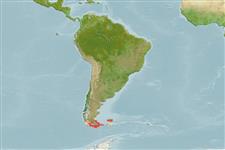Environment: milieu / climate zone / depth range / distribution range
Ecologia
marinhas demersal; intervalo de profundidade 40 - 50 m. Temperate; 52°S - 57°S
South Atlantic and South Pacific: Straits of Magellan, south of Chile and Argentina, Patagonian Region and Staten Island. Falkland Islands and subantarctic islands (Ref. 4537).
Tamanho / Peso / Idade
Maturity: Lm ? range ? - ? cm
Max length : 9.5 cm SL macho/indeterminado; (Ref. 117667)
Mainly in shallow, inshore waters, but may be found from 40-50 m. Occurs in tide pools, under rocks and among kelp (Ref. 5191). Feed on small crustaceans and common in littoral of all sub-Antarctic islands (Ref. 42041).
Ciclo de vida ou comportamento de acasalamento
Maturities | Reprodução | Spawnings | Egg(s) | Fecundities | Larvas
Females guard the eggs deposited in a nest they constructed for the four month incubation period (Ref. 89358).
Hureau, J.-C., 1990. Harpagiferidae. p. 357-363. In O. Gon and P.C. Heemstra (eds.) Fishes of the Southern Ocean. J.L.B. Smith Institute of Ichthyology, Grahamstown, South Africa. 462 p. (Ref. 5191)
Status na Lista Vermelha da UICN (Ref. 130435)
Ameaça para os humanos
Harmless
Uso pelos humanos
Pescarias: sem interesse
Ferramentas
Relatórios especiais
Baixar XML
Fontes da internet
Estimates based on models
Preferred temperature (Ref.
123201): 6.2 - 8, mean 7.1 °C (based on 8 cells).
Índice de diversidade filogenética (Ref.
82804): PD
50 = 0.5010 [Uniqueness, from 0.5 = low to 2.0 = high].
Bayesian length-weight: a=0.00537 (0.00211 - 0.01367), b=3.10 (2.88 - 3.32), in cm total length, based on LWR estimates for this (Sub)family-body shape (Ref.
93245).
Nível Trófico (Ref.
69278): 3.3 ±0.4 se; based on diet studies.
Resiliência (Ref.
120179): médio(a), tempo mínimo de duplicação da população 1,4 - 4,4 anos (Assuming Fec < 10,000).
Fishing Vulnerability (Ref.
59153): Low to moderate vulnerability (35 of 100).
